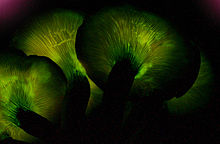- Omphalotus olearius
-
Omphalotus olearius Scientific classification Kingdom: Fungi Subkingdom: Dikarya Phylum: Basidiomycota Subphylum: Agaricomycotina Class: Agaricomycetes Order: Agaricales Family: Marasmiaceae Genus: Omphalotus Species: O. olearius Binomial name Omphalotus olearius
(DC.) Sing.Omphalotus olearius, commonly known as the jack-o'-lantern mushroom, is an orange- to yellow-gill mushroom that to an untrained eye appears similar to some chanterelles, and is most notable for its bioluminescent properties. Unlike the chanterelle, the Jack o'Lantern mushroom is poisonous. While not lethal, consuming this mushroom leads to very severe cramps, vomiting, and diarrhea. Complicating its toxicity is the fact that it smells and looks very appealing, to the extent that there are reports of repeat poisonings from individuals who were tempted to try them a second time.
Contents
Description
The Jack o'Lantern mushroom's fruiting body (its stem and cap) is an orange color. Its bioluminescence, a blue-green color, is only observable in low light conditions when the eye becomes dark-adapted. The whole mushroom doesn't glow — only the gills do so. This is due to an enzyme, called luciferase, acting upon a compound called luciferin, leading to the emission of light much as fireflies do when glowing.
Omphalotus olearius Mycological characteristics 
gills on hymenium 
cap is infundibuliform 
hymenium is decurrent 
stipe is bare 
spore print is yellow 
ecology is saprotrophic 
edibility: poisonous Similar species
Unlike the chanterelles, the Jack o'Lantern has true, sharp, non-forking gills; this is possibly the simplest trait for distinguishing between the two. Furthermore, if the Jack o'Lantern's stem is peeled, the inside is orange, while the chanterelle is a paler white on the inside stem.
The similarly poisonous mushroom Tsukiyotake (Omphalotus japonicus (Kawam.) Kirchm. & O.K. Mill., also known as Lampteromyces japonicus (Kawam.) Sing.), found in Japan and eastern Asia, emits light similar to that of the Jack o'Lantern mushroom and contains the same poison, illudin. It was confirmed in 2003 that Tsukiyotake is a relative of the Jack o'Lantern mushroom. The poisonous Western Jack o'Lantern mushroom (Omphalotus olivascens), abundant from southern to central California, is also similar to the chanterelle, but can be distinguished, as its flesh is never white.
Research and medicine
The poisonous chemical compound illudin was isolated from Omphalotus illudens. Inside the cells of the body, it reacts with DNA and creates a type of DNA damage that blocks the transcription process. This block can only be relieved by a repair system called nucleotide excision repair. Damages in non-transcribed DNA areas are left unrepaired by the cell. This property was exploited by the company MGI Pharma to develop an illudin-derivative called Irofulven for use as an anti-cancer medicine. Its application is still in the experimental phase.
External links
Categories:- Marasmiaceae
- Poisonous fungi
- Bioluminescent organisms
- Fungi of Europe
Wikimedia Foundation. 2010.


